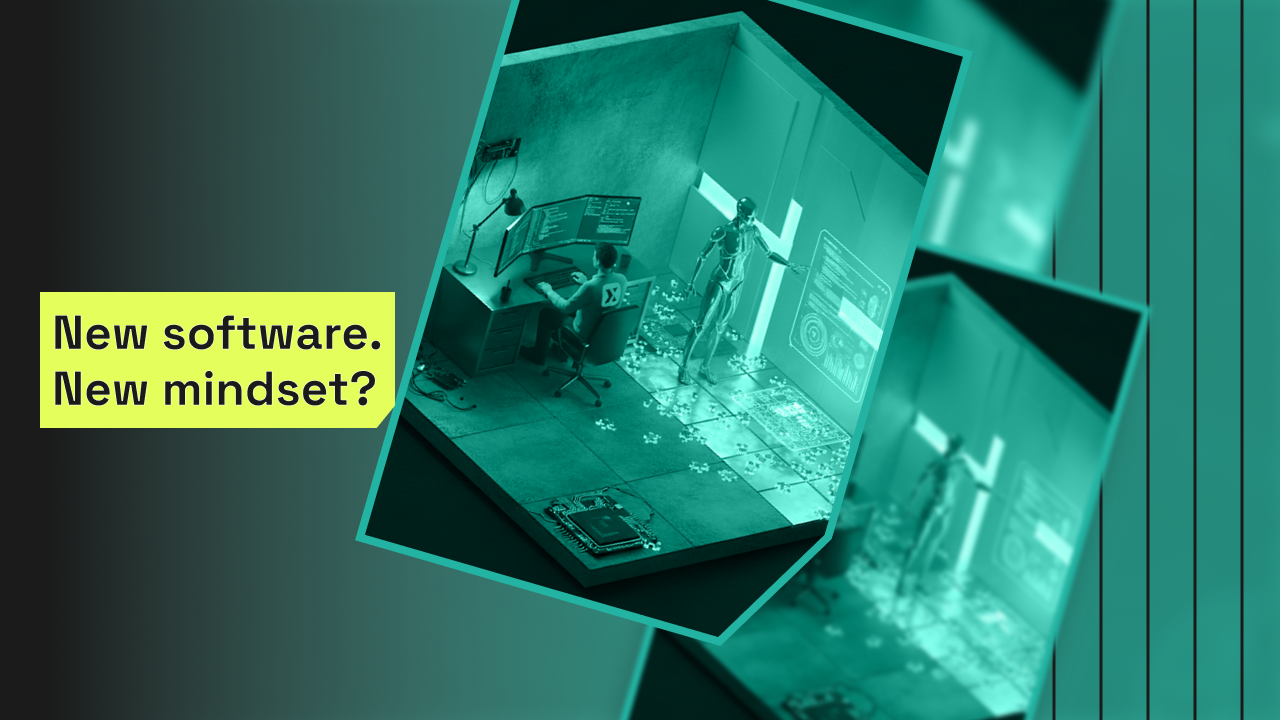Building Fast and Building Slow

Kevin Smith
5 min read • 1 May 2025
🔗 Originally published on LinkedIn
A new dialectic for software in the age of agents and intuition
For most of computing history, "building fast" wasn’t really on the menu. Software took time—weeks to plan, months to build, years to stabilise. Even the smallest feature involved a careful waltz of requirement gathering, architectural decisions, hand-rolled code, and slow-release cycles. It was, in many ways, a waterfall by necessity.
That’s changing. Radically.
Today, with large language models, no-code scaffolds, and AI copilots at our fingertips, the velocity of software creation has been redefined. Anyone with an idea and a sentence can spin up something that looks, behaves, and often feels like real software. Applications are being born in hours. Entire systems are being prototyped before lunch.
We’re entering the vibe coding era, where you build by gesturing at intent and letting intelligent agents fill in the blanks.
And that’s not just a shift in tooling. It’s a shift in mindset. In expectations. In how we think about software, and who gets to build it.
But here’s the twist: faster coding doesn’t remove the real constraints of serious software engineering. If anything, it sharpens them. Because the hard part of software was never just the typing. It was, and remains, everything that surrounds it.
That’s why in the age of fast creation, we need a new framing—one that honours both momentum and maintenance, intuition and intention. One that recognises the growing gap between what can be built quickly and what must be built to last.
That framing is simple:
Software now demands both building fast and building slow.
And the real skill is knowing when and how to switch between them.
I. The Case for Building Fast
The creative superpowers unlocked by AI are not subtle. They’re transformative.
We’re no longer limited to building line by line. We now:
- Describe functionality in natural language and get runnable prototypes.
- Generate UI layouts, database schemas, and integration scripts in seconds.
- Conduct architectural spikes by scaffolding multiple solutions in parallel.
- Explore alternative designs without committing to a single direction too soon.
This is more than just speed. It’s expressive velocity. A way of shaping software more like we sketch—loosely, intuitively, iteratively.
Fast mode thrives when ambiguity is high, stakes are low, and exploration matters more than polish. That makes it perfect for:
1. Early-stage prototyping
Pre-seed ideas, innovation spikes, internal demos—fast mode enables teams (and increasingly, non-technical founders) to move from abstract to concrete without friction. You don’t need to raise a team of developers to test a thesis anymore. You can vibe your way to a working demo in a weekend.
2. Development spikes as research
Instead of spending days debating which database or framework to use, teams can now spin up working versions of all three. Learn by doing, compare with real outputs, and choose based on feel—not just theory. This is a fundamental reframe: build as research. The artefact becomes the analysis.
3. Interface-first thinking
Product design increasingly starts with the interface—because with AI, that interface can become interactive immediately. Whether it’s a dashboard, a chatbot, or a workflow manager, we can now generate meaningful UX experiments that function just enough to be evaluated with users.
Building fast invites play. It invites exploration. And it opens the gates for non-developers to create, experiment, and contribute in ways that were previously closed off.
But it also carries risks.
Because speed, without judgement, can lead to entropy.
II. Why Building Slow Still Matters
There’s a reason software gets slower the closer it gets to production. That’s where the costs shift—from the creation of artefacts to the governance of systems.
No matter how fast you build something, the moment it becomes real—used, depended on, relied upon—everything changes. The work stops being about possibility and starts being about stewardship.
Slow mode is how you build for:
- Longevity
- Understandability
- Trust
- Change
It’s where software becomes a living system, not just a temporary expression of an idea.
That means:
- Designing clear boundaries, responsibilities, and interfaces
- Documenting intent in a way that survives people leaving
- Managing risk, failure modes, and performance under stress
- Building with an eye towards how this will be maintained, not just what it does today
And in the agentic future, where autonomous systems act with increasing independence, that work gets even more critical.
Agents need governance, not just prompting.
They need observability, override paths, memory design, behaviour constraints, and ethical defaults. This isn’t optional. It’s the foundation of trust.
You can’t vibe your way to a nuclear control system. You can’t agentify an aircraft without formal methods. You can’t build enterprise-grade agentic orchestration without deep thinking about roles, responsibilities, and recoverability.
In other words: some systems require building slow—because they must last.
III. Fast ≠ Cheap, Slow ≠ Waste
There’s a dangerous temptation to treat fast building as a free win. That now that we can code faster, we’ve eliminated the bottlenecks of software.
But that’s an illusion.
Faster code doesn’t remove the cost of:
- Designing systems people can reason about
- Creating documentation others can follow
- Ensuring behaviour remains predictable, auditable, and safe
- Upgrading over time without losing trust or functionality
Those aren’t speed problems. They’re care problems.
This is especially true for software treated as a business asset. If you're building a system that will run part of your company for the next 10 years, the velocity of initial development is a rounding error. What matters is:
- Can this system evolve?
- Can it be handed off?
- Can it be understood under pressure?
- Can it be maintained when the original author is gone?
These are slow concerns. But they’re where real ROI lives.
Because software isn’t just an expression. It’s an institutional memory. A set of frozen decisions. A living, breathing organism you have to care for.
IV. Switching Modes: When and How
The power isn’t just in having fast and slow modes. It’s in learning to switch between them with intention.
There are three common patterns:
1. Planned Phasing
This is the classic mode switch:
- Spike fast, then review slowly.
- Build a demo, then design the real thing.
It’s great for structured teams and time-boxed projects. But it risks treating slow mode as cleanup rather than foundation.
2. Event-Driven Switching
Sometimes context forces your hand.
- Users adopt your fast prototype—now you need to stabilise and scale.
- A production failure exposes architectural flaws—time to slow down and rethink.
This model is reactive—but can be powerful when paired with good sensing and psychological safety.
3. Fluid Switching
This is the craftsperson’s dance:
- Vibe out 100 lines of code, then pause to refactor with care.
- Try three UI flows quickly, then step back and architect the state model.
It requires high awareness and emotional maturity, but it leads to software that both feels alive and holds up.
The goal isn’t to be only fast or only slow.
It’s to know what mode you’re in, why you’re in it, and when it’s time to shift.
V. So Where Does Vibe Coding Fit?
In serious systems, vibe coding isn’t the main act. It’s the catalyst.
Used well, it can:
- Accelerate exploration and reduce friction
- Generate documentation and shared context
- Act as a rubber duck, a spike tool, a brainstorming partner
- Reduce the emotional cost of experimentation
- Speed up the start of something that will need to endure
Used poorly, it can create a mess faster than you can clean it up.
The difference? Intentionality.
Vibe coding belongs at the edges of the system:
- At the start, when we’re exploring ideas
- Around the system, when we’re building internal tooling, scaffolds, glue code
- In the process, as a second brain helping us think
But not in the heart of the system—not where trust, longevity, and human understanding are the actual product.
VI. Conclusion: Software as Practice
We’re entering a new era of software creation. One where speed is democratised, and intuition is no longer constrained by syntax.
But in this era, discipline matters more than ever.
The challenge isn’t how fast we can go. It’s how wisely we switch between fast and slow. How thoughtfully we balance exploration and stewardship. How honestly we reckon with the fact that some software is an experiment, and some software is a promise.
Fast is for finding the shape. Slow is for making it strong. Engineering is for learning how to do both—at the right time, with the right intent.
Because the future doesn’t belong to the fastest builders. It belongs to those who know when to build fast, and when to slow down and build right.
👉 Learn more about AI Native Software Development
This article was originally written and published on LinkedIn by Kevin Smith, CTO and founder of Dootrix.

Kevin Smith

.png)
